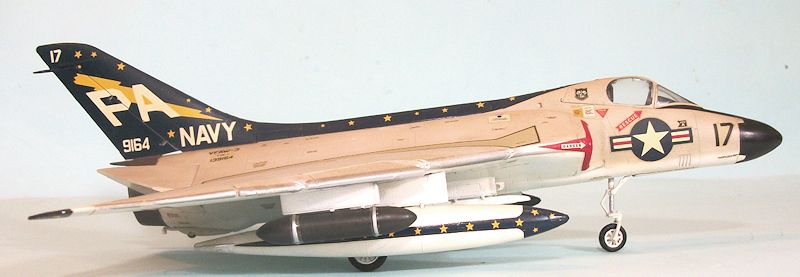
| KIT #: | 61055 |
| PRICE: | $43.00 SRP |
| DECALS: | Two options |
| REVIEWER: | Tom Cleaver |
| NOTES: |

| HISTORY |
The Douglas F4D-1 Skyray
was the first Navy fighter capable of that could exceed Mach 1 in level flight.
It was the first carrier-based fighter to hold the
world's absolute speed record, and was the last fighter built by the Douglas
Aircraft Company.
The F4D-1, known to its pilots as the "Ford," was the
first successful delta-wing fighter.
Many consider its batwing shape to be the most
graceful-looking jet fighter ever built.
The aircraft was the
result of a 1947 spedification calling for a jet-powered carrier-based
interceptor capable of intercepting and destroying an enemy aircraft flying at
550 mph at 50,000 feet within five minutes of the alarm being sounded.
The design was based on the work of Dr. Alexander
Lippisch with high-speed tailless
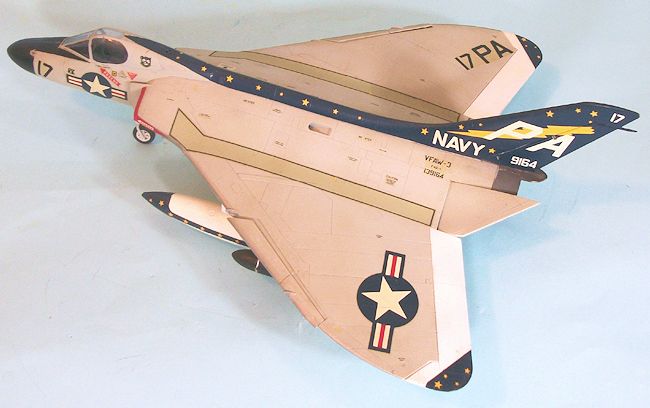 aircraft.
Douglas engineers Gene Root and A.M.O. Smith had visited Paris the week
following V-E Day, and heard a briefing by Lippisch, then in Allied custody, on
the flying-wing interceptors he believed were aviation's future. Smith and Root
returned to El Segundo and the legendary Douglas design works run by Edward H.
Heinemann, with a treasure trove of German wind tunnel data.
Heinemann would receive the Collier Trophy in 1957 for
the design of the Skyray.
aircraft.
Douglas engineers Gene Root and A.M.O. Smith had visited Paris the week
following V-E Day, and heard a briefing by Lippisch, then in Allied custody, on
the flying-wing interceptors he believed were aviation's future. Smith and Root
returned to El Segundo and the legendary Douglas design works run by Edward H.
Heinemann, with a treasure trove of German wind tunnel data.
Heinemann would receive the Collier Trophy in 1957 for
the design of the Skyray.
The original
specification called for use of the Westinghouse J-40, perhaps the single worst
jet engine ever created, responsible for the under-performance of nearly all of
the Navy's second generation of jet aircraft.
Fortunately, Douglas took a conservative approach and
designed the airframe to be capable of taking another powerplant.
With the failure of the J-40, the Skyray received a
second lease on life when the decision was made to use the wonderful J-57, one
of the best jet engines ever made. With an afterburner, the F4D-1 was the first
Navy fighter capable of exceeding Mach 1 in level flight, and had a climb
performance of 18,300 feet per minute.
On May 23, 1958, the Skyray set a world time-to-climb
record of 49,221 feet in 2 minutes 36 seconds, climbing the entire way at 70
degrees, flown by Marine Corps Major Edward N. LeFaivre from NAS Point Mugu.
This writer well remembers seeing F4D-1s of VFAW-3 make maximum-performance
take-offs at NAS North Island in the early 1960s.
Those beautiful jets pulled up into near-vertical
climbs, and were a speck in the sky in a matter of moments.
In 1954, the airplane set the World's Absolute Speed
record at 752.943 mph at an altitude of 1,000 feet over the Salton Sea.
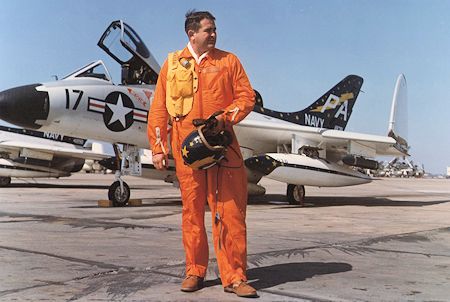 The
Skyray was operated by 11 fleet squadrons and two Naval Reserve units, as well
as eight Marine Corps squadrons, between 1956-64. VC-3, which later became
VF(AW)-3, was the first squadron to equip with the Skyray in April 1956,
transitioning completely from the F3D-2 Skynight in 1959.
23-victory World War II ace Commander Eugene Valencia,
the last Navy World War II ace to command a fighter squadron, led VF(AW)-3 when
it was assigned to NORAD that year, with the squadron averaging one or two
actual scrambles and two or three training sorties per day. VF(AW)-3
consistently outperformed USAF interceptor squadrons in scramble time and
intercept effectiveness and won NORAD's "best performing unit" trophy, twice.
VFAW-3 kept the Skyray until April 1963.
The
Skyray was operated by 11 fleet squadrons and two Naval Reserve units, as well
as eight Marine Corps squadrons, between 1956-64. VC-3, which later became
VF(AW)-3, was the first squadron to equip with the Skyray in April 1956,
transitioning completely from the F3D-2 Skynight in 1959.
23-victory World War II ace Commander Eugene Valencia,
the last Navy World War II ace to command a fighter squadron, led VF(AW)-3 when
it was assigned to NORAD that year, with the squadron averaging one or two
actual scrambles and two or three training sorties per day. VF(AW)-3
consistently outperformed USAF interceptor squadrons in scramble time and
intercept effectiveness and won NORAD's "best performing unit" trophy, twice.
VFAW-3 kept the Skyray until April 1963.
After the Cuban
Revolution, VF(AW)-3 sent a detachment of six aircraft ("Detachment Echo") to
NAS Key West, Florida, in 1961, where they operated under control of the
Continental Air Defense Command (CONAD). The crews were rotated every eight
weeks.
After Cuba received MiG-21 fighters in January 1962, VF(AW)-3 kept four
F4Ds on five-minute alert at all times.
Detachment Echo participated in the Cuban Missile Crisis
in 1962.
That event and the tour VF(AW)-3 served on Taiwan in 1959 during the
Second Taiwan Straits Crisis were the only times the F4D-1 came close to seeing
actual combat.
| THE KIT |
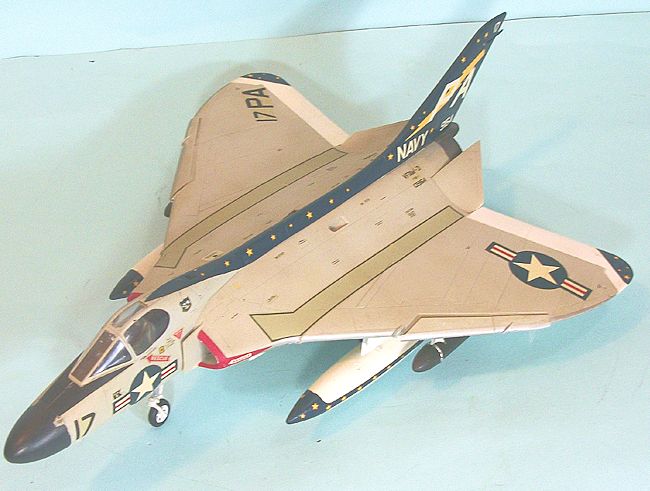
| CONSTRUCTION |
The kit is typical
Tamiya: easy to assemble.
It can be assembled with the wings folded or spread.
Cockpit detail is sufficient, though I decided I would
assemble this kit with the canopy closed, so as not to break the beautiful lines
of the Skyray.
I put a large fishweight in the nose, which guaranteed
nose-sitting, and assembled the tailerons in the up position, which is how most
Skyrays sat when on the ground with the hydraulics turned off.
| COLORS & MARKINGS |
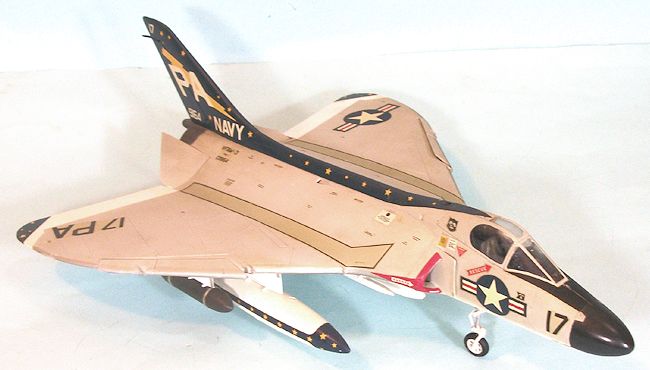
| CONCLUSIONS |

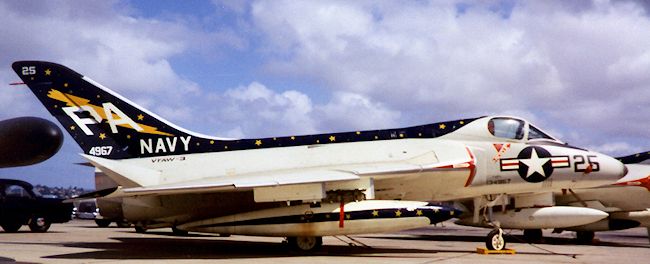 Review
kit courtesy of my wallet.
Review
kit courtesy of my wallet.
If you would like your product reviewed fairly and fairly quickly, please contact the editor or see other details in the Note to Contributors.